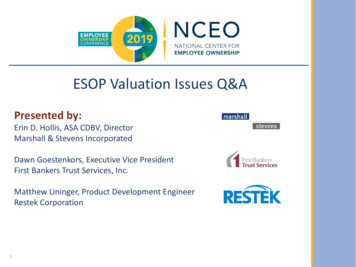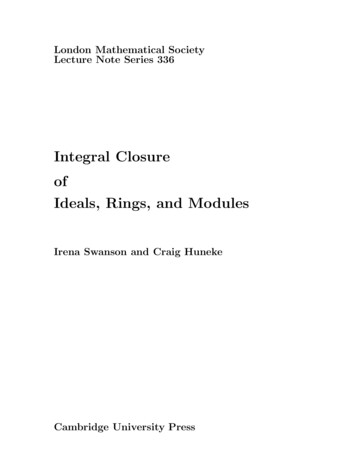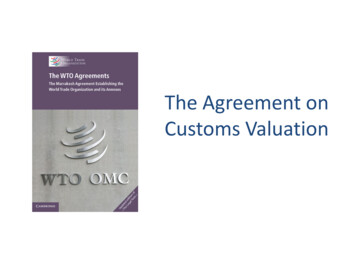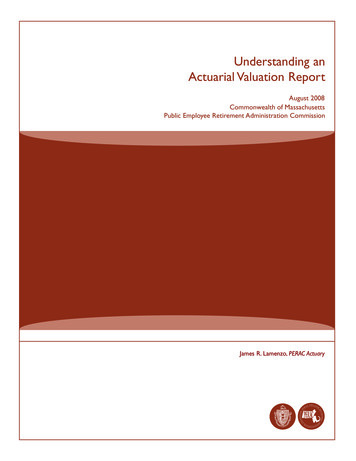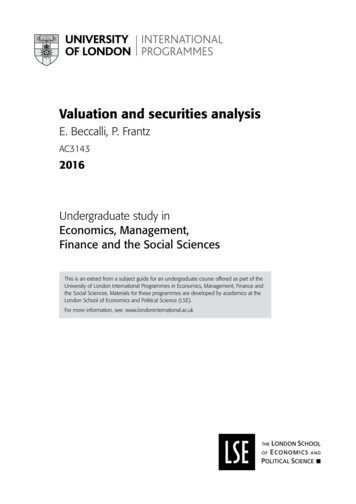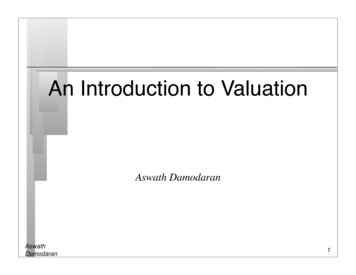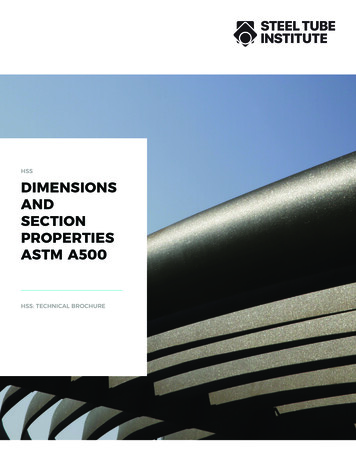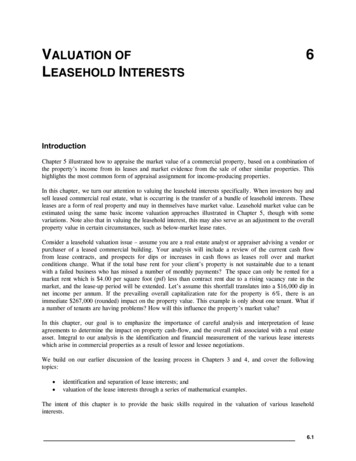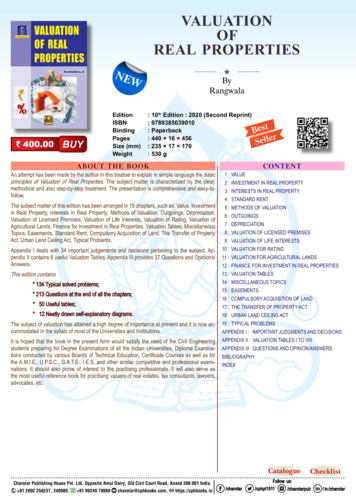
Transcription
VALUATIONOFREAL PROPERTIESNE W 400.00BUYEditionISBNBindingPagesSize (mm)WeightByRangwala: 10th Edition : 2020 (Second Reprint): 9789385039010: PaperbackBestr: 440 16 456Selle: 235 17 170: 530 gABOUT THE BOOKCONTENTAn attempt has been made by the author in this treatise to explain in simple language the basicprinciples of Valuation of Real Properties. The subject matter is characterized by the clear,methodical and also step-by-step treatment. The presentation is comprehensive and easy-tofollow.1 : VALUEThe subject matter of this edition has been arranged in 19 chapters, such as: Value, Investmentin Real Property, Interests in Real Property, Methods of Valuation, Outgoings, Depreciation,Valuation of Licensed Premises, Valuation of Life Interests, Valuation of Rating, Valuation ofAgricultural Lands, Finance for Investment in Real Properties, Valuation Tables, MiscellaneousTopics, Easements, Standard Rent, Compulsory Acquisition of Land, The Transfer of PropertyAct, Urban Land Ceiling Act, Typical Problems.5 : METHODS OF VALUATION2 : INVESTMENT IN REAL PROPERTY3 : INTERESTS IN REAL PROPERTY4 : STANDARD RENT6 : OUTGOINGS7 : DEPRECIATION8 : VALUATION OF LICENSED PREMISES9 : VALUATION OF LIFE INTERESTSAppendix I deals with 34 important judgements and decisions pertaining to the subject. Appendix II contains 8 useful Valuation Tables. Appendix III provides 37 Questions and Opinions/Answers.10 : VALUATION FOR RATINGThis edition contains13 : VALUATION TABLES11 : VALUATION FOR AGRICULTURAL LANDS12 : FINANCE FOR INVESTMENT IN REAL PROPERTIES14 : MISCELLANEOUS TOPICS* 134 Typical solved problems;15 : EASEMENTS* 213 Questions at the end of all the chapters;16 : COMPULSORY ACQUISITION OF LAND* 50 Useful tables;17 : THE TRANSFER OF PROPERTY ACT* 12 Neatly drawn self-explanatory diagrams.18 : URBAN LAND CEILING ACTThe subject of valuation has attained a high degree of importance at present and it is now accommodated in the syllabi of most of the Universities and Institutions.19 : TYPICAL PROBLEMSIt is hoped that the book in the present form would satisfy the need of the Civil Engineeringstudents preparing for Degree Examinations of all the Indian Universities, Diploma Examinations conducted by various Boards of Technical Education, Certificate Courses as well as forthe A.M.I.E., U.P.S.C., G.A.T.E., I.E.S. and other similar competitive and professional examinations. It should also prove of interest to the practising professionals. It will also serve asthe most useful reference book for practising valuers of real estates, tax consultants, lawyers,advocates, etc.APPENDIX II : VALUATION TABLES I TO VIIIAPPENDIX I : IMPORTANT JUDGMENTS AND DECISIONSAPPENDIX III : QUESTIONS AND OPINION/ANSWERSBIBLIOGRAPHYINDEXCatalogueCharotar Publishing House Pvt. Ltd. Opposite Amul Dairy, Old Civil Court Road, Anand 388 001 India 91 2692 256237, 240089, 91 99249 klistFollow us:/charotar/cphpl1511/charotarpub/ in /charotar
VALUATION OF REAL PROPERTIESDETAILED CONTENTSChapter 1 VALUE1-1. General1-2. Real properties and personal properties1-3. Differences between the real properties and personal properties1-4. Valuation1-5. Doctrine of estate(1) Free tenure (2) Unfree tenure1-6. Types of estates in England(1) Life estate (3) Fee simple estate(2) Fee tail estate1-7. Land system in India(1) Zamindari or landlord tenure system(2) Malguzari land tenure system(3) Mahalwari land tenure system(4) Raitwari or independent land tenure system1-8. Cost, price and value(1) Cost (3) Value(2) Price1-9. Concept of the term value(1) Utility (3) Demand(2) Scarcity (4) Transferability1-10. Purposes of valuation(1) Betterment charges (6) Insurance(2) Balance-sheet (7) Mortgages(3) Buying and selling of (8) Reinstatementthe properties (9) Rent determination(4) Compulsory acquisition (10) Security of loans(5) Court fees(11) Taxation or fiscal purpose1-11. Different forms of value(1) Accommodation value (9) Monopoly value(2) Annual value(10) Potential value(3) Book value(11) Rateable value(4) Distress value(12) Replacement value(5) Goodwill value(13) Salvage value(6) Highest and best use(14) Scrap valuevalue(15) Sentimental value(7) Liquidation value(16) Speculative value(8) Market value1-12. Supply and demand forces(1) Supply side(2) Demand side1-13. Occupation value and investment value(1) Government Acts(2) Intensity of demand(3) Trade conditions1-14. Factors affecting changes in market value(1) Changes in building technology(2) Changes in fashion and taste(3) Changes in proportion of single people to married people(4) Changes in quality of area(5) Changes in the age distribution of the population(6) Designs of property(7) Means of communication(8) Migration tendencies(9) Money supply(10) Planning control(11) Population strength(12) Unstable time1-15. Concepts of right of compulsory purchase and value in India1-16. Emergence of profession of real estate valuation in India1-17. Classification of the valuers1-18. Role of the valuer(1) Acknowledgment of market conditions(2) Competency(3) Cost of outgoings(4) Effect of statutes(5) General experience(6) Knowledge of building costs(7) Legal complications(8) Specialised buildings(9) Value and cost1-19. New horizons of valuation(1) Environment (3) Rapid transit system(2) Neighbourhood (4) Time sharing premisesQUESTIONS 1Chapter 2 INVESTMENT IN REAL PROPERTY2-1. General2-2. Characteristics of land2-3. Investment2-4. Investment market(1) Liquidity preference theory(2) Loanable fund theory2-5. Investment opportunities(1) Articles for use(2) Gilt-edged securities(3) Local authority loans(4) Insurance(5) Fixed deposits in banks(6) Company deposits(7) Small Saving Schemes of Government of India(8) Relief bonds of Reserve Bank of India(9) Mutual fund schemes(10) Gold exchange traded funds(11) Units of the Unit Trust of India(12) Convertible debentures(13) Shares(14) Real property as an investment2-6. Characteristics of ideal investment(1) Capital appreciation prospects(2) Costs of purchase and sale(3) Divisibility of holdings(4) Ease of purchase and sale(5) Security of income(6) Security of capital2-7. Interest on capital2-8. Nature of real property(1) Amount of investment (6) Influence on yields(2) Central market (7) Joint ownership(3) Clearance of title (8) Physical inspection(4) Government action (9) Durability(5) Heterogeneity(10) Source of income2-9. Factors affecting real property market(1) Climatic conditions (6) Lack of market information(2) Communications (7) Local economy(3) Fashion and local (8) Potentialitydemand (9) Services(4) Government policies(10) State of repair(5) Individual aspects of(11) Time elementproperty(12) Topography of the area2-10. Determination of value of real property2-11. Estate brokersQUESTIONS 2Chapter 3 INTERESTS IN REAL PROPERTY3-1. General3-2. Types of interests3-3. Freehold interests(1) Law of the land (2) Right of others3-4. Leasehold interests(1) Reasons for creating leasehold interest(2) Nature of leasehold interest(3) Renewal and extension of leases(4) Theory of sinking fund(5) Lessor and lessee(6) Forms of lease(7) Lease and license3-5. Difference between freehold and leasehold property3-6. Mortgage(1) Amount of loan (6) Subsequent mortgages(2) Insurance (7) Third party guarantee(3) Leasehold property (8) Types of mortgage lenders(4) Period of loan (9) Valuation(5) Remedies to recover loanCharotar Publishing House Pvt. Ltd. Opposite Amul Dairy, Old Civil Court Road, Anand 388 001 India 91 2692 256237, 240089, 91 99249 ow us:/charotar/cphpl1511/charotarpub/ in /charotar
VALUATION OF REAL PROPERTIESDETAILED CONTENTS3-7. Reverse mortgage(1) Difference between reverse mortgage and other homeloans(2) Comparison between reverse mortgage and forward orregular mortgages3-8. Development process3-9. Typical problemsQUESTIONS 3Chapter 4 STANDARD RENT4-1. General4-2. Objects of Rent Act4-3. Meaning of standard rent4-4. Exemptions from the Rent Act4-5. Process of fixing standard rent4-6. Methods of ascertaining standard rent(1) Comparative method(2) Investment theory4-7. Important factors(1) Cost of construction(2) Loading and apportionment of land value(3) Period of first letting4-8. Inheritance of tenancy right(1) Business premises(2) Lone tenant(3) Members of family(4) Single person(5) Transfer by will4-9. Paying guests and Rent Act4-10. Recovery of possession from tenant by landlord(1) Bad behaviour of tenant (4) Failure to pay rent(2) Domestic animals (5) Personal requirement of(3) Erection of permanentlandlordstructure (6) Undesired use of property4-11. Conclusion(1) Application (6) Permitted increases(2) Cut-off period (7) Repairs and tax obligations(3) Cut-off rent limit (8) Smooth legal procedure(4) Exemptions (9) Take-over of old buildings(5) Legalising the pugree4-12. Typical problemsQUESTIONS 4Chapter 5 METHODS OF VALUATION5-1. General5-2. Methods of valuation for open lands(1) Comparative method(2) Abstractive method(3) Belting method5-3. Methods of valuation for lands with buildings5-3-1. Rental method(1) Definition of rent(2) Characteristics of land(3) Theory of economic rent(4) Rent in popular sense(5) Determination of rental value(6) Effect of legislation(7) Effect of capital improvements on rental value(8) Procedure of method(9) Rate of interest(10) Rule 1BB of Wealth-tax Act(11) Schedule III, Part B of Wealth-tax Act5-3-2. Direct comparisons of the capital value5-3-3. Valuation by reference to profits5-3-4. Valuation based on the cost or contractor’s method5-3-5. Residual or development method5-4. Conclusion5-5. Typical problemsQUESTIONS 5Chapter 6 OUTGOINGS6-1. Definition6-2. Usual types of outgoings(1) Municipal taxes(2) Government taxes(3) Annual repairs and maintenance(4) Management and collection(5) Insurance(6) Vacancies and bad debts(7) Sinking fund(8) Miscellaneous6-3. Typical problems6-4. Gross income and net income6-5. ConclusionQUESTIONS 6Chapter 7 DEPRECIATION7-1. Meaning of the term7-2. Depreciation as cost in operation7-3. Depreciation as decrease in worth7-3-1. Physical conditions7-3-2. Functional obsolescence(1) Inadequacy or over-adequacy(2) Lacking in utility(3) Obsolete necessities(4) Outmoded design(5) Out of the way or odd design7-3-3. Economic obsolescence(1) Changes in character(3) Nearness to nuisancesand use(4) Over supply(2) Changes in laws(5) Social changes7-4. Difference between depreciation and obsolescence7-5. Methods for estimating cost depreciation(1) Straight-line method(2) Constant percentage method(3) Quantity survey method(4) Sinking fund method(5) Sum of the digits method(6) Unit cost method7-6. Cost of construction(1) Area of building(2) Cubical contents of building(3) Detailed or itemwise method7-7. Cost depreciation and value depreciation7-8. Reproduction cost and replacement cost7-9. Depreciation and depletion7-10. Conclusion7-11. Typical problemsQUESTIONS 7Chapter 8 VALUATION OF LICENSED PREMISES8-1. General8-2. General principle of valuation(1) Closing of business(2) Liabilities8-3. Valuation of a cinema(1) First method(2) Second method8-4. Valuation of a hotel(1) Important factors(2) Aspects8-5. Typical problemsQUESTIONS 8Chapter 9 VALUATION OF LIFE INTERESTS9-1. General9-2. Types of life interest(1) Lessee for life(2) Tenant for life9-3. Mortality tables9-4. Compilation of mortality tables9-5. Application of mortality tables9-6. Jellicoe’s formula9-7. Typical problemsQUESTIONS 9Charotar Publishing House Pvt. Ltd. Opposite Amul Dairy, Old Civil Court Road, Anand 388 001 India 91 2692 256237, 240089, 91 99249 ow us:/charotar/cphpl1511/charotarpub/ in /charotar
Chapter 10 VALUATION FOR RATING10-1. General10-2. Definitions(1) Assessment(4) Annual value(2) Rate and tax(5) Rateable value(3) Rate-payer10-3. Principles of rating(1) Principle of Communibus Annis(2) Principle of Rebus Sic Stantibus10-4. Rent as evidence of annual value(1) Benefits to owner(5) Property on lease(2) Foresight of tenant(6) Repairs of existing building(3) Occupied by owner(7) Short-term tenancies(4) Premium(8) Special circumstances10-5. Hypothetical tenant and hypothetical rent(1) Actual occupier(6) Special necessities of actual(2) Actual rentoccupier(3) Adoption of principle (7) Standard rent(4) Competition(5) Residential accommodation of staff10-6. Exemptions from rateability(1) Charitable institutions(2) Properties of Government(3) Houses of ambassadors(4) Literary and scientific societies(5) Public religious places(6) Land struck with sterility(7) Properties of local body(8) Special properties(9) Burial grounds(10) Miscellaneous10-7. Process of assessment10-8. Methods of assessment(1) Direct or indirect rental evidence(2) Contractor’s test(3) Profit method(4) Site value method10-9. ConclusionQUESTIONS 10Chapter 11 VALUATION FOR AGRICULTURAL LANDS11-1. General11-2. Importance(1) Crop loans(3) Investment loans(2) Development loans11-3. Factors affecting value of agricultural land(1) Cottages and buildings (6) Size of farm(2) Fencing and gates(7) Title of land(3) General situation(8) Types of crops(4) Quality of soil(9) Water supply and electricity(5) Roads and approaches11-4. Methods of valuation of agricultural lands11-4-1. Income capitalisation method (ICM)11-4-2. Sales statistics method (SSM)(1) Cottages and buildings (3) Valuation date(2) Field-to-field valuation11-5. Agricultural land and direct tax lawsQUESTIONS 11Chapter 12 FINANCE FOR INVESTMENT IN REALPROPERTIES12-1. General12-2. Terms of borrowing(1) Rate of interest(3) State of economy(2) Reputation of borrower (4) Type of property12-3. Sources of borrowing(1) For residential properties(2) For commercial and industrial properties12-4. Gearing and equity(1) Low-geared(2) High-geared(1) Cost of borrowing(2) Increase in interest(3) Increase in rent12-5. Conclusion12-6. Typical problemsQUESTIONS 12Chapter 13 VALUATION TABLES13-1. GeneralTABLE I:To find the amount to which Re. 1/- will accumulateat the end of a given term at compound interestTABLE II: To find the present value of Re. 1/- receivable at theend of a given termTABLE III: To find the amount to which Re. 1/- per annum investedat the end of each year will accumulate in a given timeat compound interestTABLE IV: To find the amount of the annual sinking fund for theredemption of Re. 1/- capitalTABLE V: To find the present value of Re. 1/- per annum for agiven number of years allowing simple interest on thecapital and accumulation of an annual sinking fundTABLE VI: To find Y.P. of a reversion to a perpetuity after a givennumber of yearsTABLE VII: To find the annuity Re. 1/- will purchase on the singlerate principleTABLE VIII: To find the depreciation percentage based on sinkingfund methodChapter 14 MISCELLANEOUS TOPICS14-1. General14-2. Accommodation land and accommodation works14-3. Amortization14-4. Annuity14-5. Capitalised value14-6. Capital gain tax and cost inflation index14-7. Deferred or reversionary land value14-8. Dilapidations14-9. Discounted cash flow(1) Net present value (or N.P.V.) method(2) Internal rate of return (or I.R.R.) method14-10. Encumbrance factor14-11. Floating F.S.I.14-12. Forms of rent(1) Rack rent(10) Standard rent(2) Head rent(11) Nominal rent(3) Leasehold or lease rent (12) Acknowledgement rent(4) Statutory rent(13) Situation rent(5) Ground rent(14) Monopoly rent(6) Improved rent(15) Intangible rent(7) Profit rent(16) Sitting rent(8) Annual or monthly or (17) Rent chargeweekly rent(18) Gross rent(9) Contractual rent(19) Net rent14-13. Life of structures14-14. Mesne profits14-15. Mobilisation fund14-16. Property tax valuation: (municipal taxation)14-17. Rate of interest(1) Money and banking (5) Factories and warehouses(2) Bank rate (6) Residential properties(3) Shops (7) Agricultural properties(4) Offices14-18. Record of rights(1) Category of land (6) Nature of holding(2) Classification of land (7) Occupant of land(3) Encumbered land (8) Period of validity(4) Holder of land (9) Restriction on transfer(5) Land under acquisition or reservationCharotar Publishing House Pvt. Ltd. Opposite Amul Dairy, Old Civil Court Road, Anand 388 001 India 91 2692 256237, 240089, 91 99249 ow us:/charotar/cphpl1511/charotarpub/ in /charotar
14-19. Rent fixation14-20. Stamp duty14-21. Valuation as a going concern14-22. Valuation under Direct Tax Laws(1) Valuation under Income Tax Act(2) Valuation under Wealth-tax Act(3) Valuation under Gift Tax Act14-23. Year’s purchaseQUESTIONS 14Chapter 15 EASEMENTS15-1. General15-2. Definition15-3. Essential characteristics of easements15-4. Creation of easements(1) By grant(2) By necessity(3) By quasi-necessity(4) By prescription(5) By lost grant presumed from immemorial user(6) By custom(7) By transfer of dominant heritage(8) By legislation(9) By the operation of the doctrine of acquiescence15-5. Extinguishment of easements(1) By dissolution of right of servient owner(2) By release(3) By revocation(4) By expiration of period(5) By happening of event(6) By end of necessity(7) By easement becoming useless(8) By permanent change in dominant heritage(9) By permanent change in servient heritage due tosuperior force(10) By destruction of either heritage(11) By unity of ownership(12) By total non-enjoyment15-6. Easements and natural rights15-7. Effect on valuation due to easement15-8. Typical problemsQUESTIONS 15Chapter 16 COMPULSORY ACQUISITION OF LAND16-1. General16-2. The Land Acquisition Act, 1894(1) Basic principles(2) Procedure under The Land Acquisition Act, 189416-3. Important aspects of the L.A. Act, 1894(1) Public purpose(2) Proposal for acquisition(3) Compensation(4) Solatium(5) Severance(6) Injurious affection(7) Loss of earnings16-4. Land Acquisition, Rehabilitation and Resettlement (LARR) Bill16-5. ConclusionQUESTIONS 16Chapter 17 THE TRANSFER OF PROPERTY ACT17-1. General17-2. Meaning of transfer(1) Family arrangement(2) Partition17-3. Definition of transfer of property17-4. Requirements of a valid transfer17-5. Contingent interest17-6. Conditional transfer17-7. Sales of immovable property(1) Rights and liabilities of seller(2) Rights and liabilities of buyer17-8. Mortgages of immovable property(1) Simple mortgage(2) Mortgage by conditional sale(3) Usufructuary mortgage(4) English mortgage(5) Mortgage by deposit of title deeds(6) Anomalous mortgage17-9. Leases of immovable property17-10. Exchanges17-11. Gifts17-12. Actionable claims17-13. ConclusionQUESTIONS 17Chapter 18 URBAN LAND CEILING ACT18-1. General18-2. Selection of towns18-3. Objects of the Act18-4. Important provisions in the Act(1) Definitions(2) Transfer of vacant land(3) Acquisition of excess land(4) Payment of amount for the acquired vacant land(5) Distribution of excess vacant land(6) Exemptions(7) Construction of future residential buildings(8) Procedural and miscellaneous matters18-5. Effects of the U.L.C. Act(1) Absence of skyscrapers(2) Administrative arrangement(3) Danger of too many houses for weaker sections(4) Development of small towns(5) Heterogenous communities(6) Role of urban development authorities(7) Valuation of urban properties18-6. SummaryQUESTIONS 18Chapter 19 TYPICAL PROBLEMSAppendix IIMPORTANT JUDGMENTS AND DECISIONSAppendix IIVALUATION TABLES I TO VIIIAppendix III QUESTIONS AND OPINION/ANSWERSBIBLIOGRAPHYIndexCharotar Publishing House Pvt. Ltd. Opposite Amul Dairy, Old Civil Court Road, Anand 388 001 India 91 2692 256237, 240089, 91 99249 ow us:/charotar/cphpl1511/charotarpub/ in /charotar
1-2. Real properties and personal properties 1-3. Differences between the real properties and personal properties 1-4. Valuation 1-5. Doctrine of estate (1) Free tenure (2)Unfree tenure 1-6. Types of estates in England (1) Life estate (3)Fee simple estate (2) Fee tail estate 1-7. Lan
